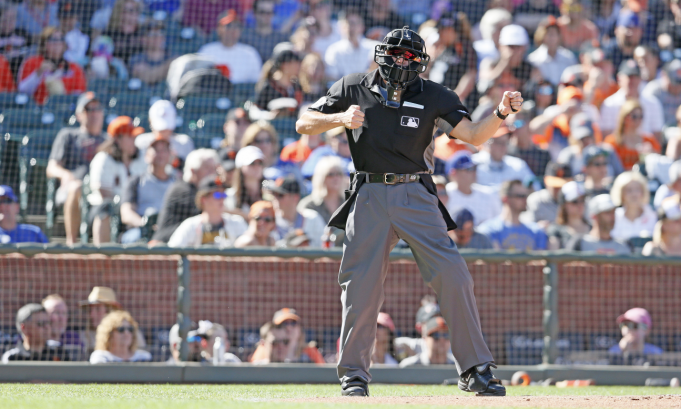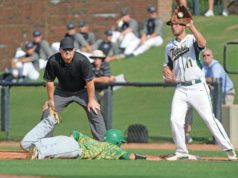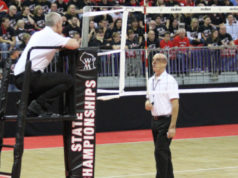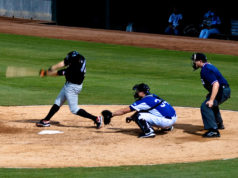I once worked a college game with an umpire with the proverbial postage-stamp strike zone. It lasted three hours, 31 minutes, and featured as much head-shaking by pitchers and griping by folks in the dugout as I guess they figured they could get away with without being tossed. It was a joke, for with all of the walks the score ended up in double digits. Afterward, in the dressing room, my frustration boiled over when my partner said he thought he only missed two pitches. I replied, “Per batter? That’s about right.”
I was a “pitcher’s umpire” throughout my career, and I believe this accounted for much of the success I was fortunate to have. I gave as much high, low, inside and outside as I felt I could without going counter to the rulebook and putting hitters at a disadvantage. When I encountered teams that hadn’t seen me, batters would leave the plate shaking their heads for the first couple of innings, after which, having gotten the message, they came up intent on swinging the bat. When hitters who knew me saw me walking to the plate before the game with my mask in hand, they knew to be aggressive from the get-go; pitchers started salivating. I loved it.
I’ve conducted many clinics, and one statement I repeatedly made that many umpires told me resonated with them was when a pitch leaves the pitcher’s hand, assume it’s a strike until proven otherwise. This keeps the game moving instead of degenerating into the kind of snail’s-pace affair I described above. It’s especially important to do this in lower levels of ball, where pitchers sometimes couldn’t find the strike zone with radar. Don’t get me wrong – I’m not talking about calling strikes on pitches at shin level or three inches off the plate. What I mean is going to the outermost limits of the defined strike zone. For me, the black border around the plate is part of it, and if I thought one thread of the ball passed over one grain of that border on the inside or outside part of the plate, my right hand went out. Similarly, a thread of the ball catching the bottom part of the batter’s knees when the pitch passed over the plate made it a strike. What this added up to was pitchers knew I would call strikes on their “money pitch” — the one that just catches the corner at the bottom of the batter’s knees. Call this a ball and we’re in for a long day.
I tried to stay with the same zone pitch to pitch for the entire game. Some umpires believe in starting out with a large zone and reining it in after they’ve gotten hitters swinging the bat. Not me. Because we can’t pull out a microphone and tell people we’re about to change things, they’ll simply conclude we’re inconsistent. I also never bought into the theory we can be large on the first two strikes but the third one must “be there.” As a pitcher, you’ve told me what your zone is on the first two strikes; now, when it really counts and I aim for the same spot, you’re going to change it?
I never gave catchers a break so I could stay on good terms with them, as I’ve heard some folks do. I was as liberal on the inside part of the plate as on the outside. On both sides, thread of ball, plus grain of black border, equals strike. Finally, I didn’t change my zone in lopsided games. I once worked an NCAA tournament game where a team down, 15-0, in the seventh inning came back to win, 18-15. If I had stretched the zone when the game seemed out of hand, it would have been hard to make it legitimate again when things tightened up.
Within limits, I eschewed the philosophy strikes shouldn’t be called unless the catcher frames and presents the pitch properly. You hear this in pro umpire schools, but many catchers in college aren’t that proficient, to say nothing of those at lower levels. If we take away legitimate strikes because of their presentation, we’ll be in for a long day. I didn’t let them reach way across their body or drop their mitt so much they almost caught the pitch in the dirt, but I didn’t penalize them if their glove moved a little as the pitch arrived or flipped over to catch a low pitch.
I also checked with my partner after the first couple of innings to see if I was “on” that day. Sometimes we think we’re doing fine when our zone is actually larger or smaller than it should be. And I re-assessed if catchers or pitchers grumbled, especially ones I knew — most players are really pretty honest — unless I knew them to be chronic whiners.
Once, I started a College World Series game by balling the first two pitches — sliders around the outside corner. I swore they were outside, but when the catcher, who I knew, told me that both were right there, it made me think twice, and I realized they were. I was setting up too far inside and not getting a good look. Had I blown him off, it may have taken awhile to get back on track. On the plus side, the pressure of working a perfect game is off when you miss the first pitch!
In sum, just as pitchers can be too fine, so can we. Go into games with the mindset you’re going to call borderline pitches strikes. No one wants to see a lot of balls called, unless it’s one of those games where it can’t be avoided. Moreover, if you want to advance, having a tight zone will hurt. No college coordinator I know wants to see postage-stamp zones. Their attitude, and mine, is keep the game moving and make the hitters swing the bat.
Jon Bible, Austin, Texas, worked seven NCAA Division I College World Series. He is the 2019 recipient of the National Collegiate Umpire Award from the National College Baseball Hall of Fame.
What's Your Call? Leave a Comment:
Note: This article is archival in nature. Rules, interpretations, mechanics, philosophies and other information may or may not be correct for the current year.
This article is the copyright of ©Referee Enterprises, Inc., and may not be republished in whole or in part online, in print or in any capacity without expressed written permission from Referee. The article is made available for educational use by individuals.


















